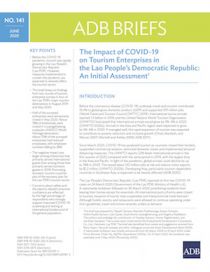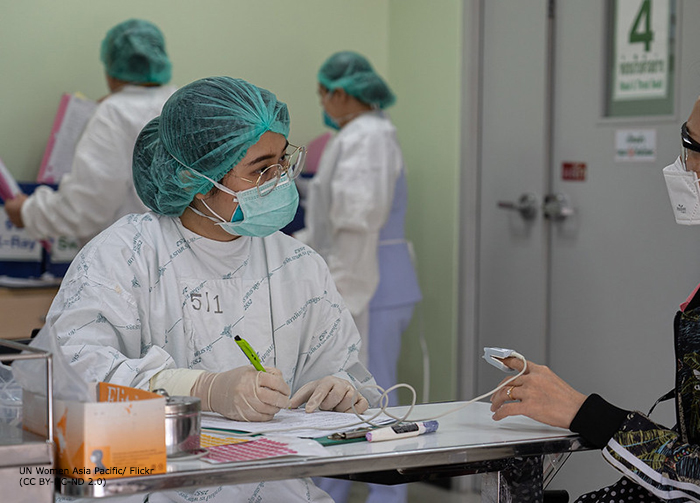
Food Security in Asia and the Pacific amid the COVID-19 Pandemic
This brief outlines the implications of the coronavirus disease (COVID-19) pandemic for food security in Asia and the Pacific and suggests policy responses.
The Asian Development Bank approved the technical assistance Strengthening Regional Health Cooperation in the Greater Mekong Subregion – Phase 2 on 2 December 2024. This technical assistance supports the implementation of the new GMS Health Cooperation Strategy 2024-2030. Strengthening regional health cooperation will help realize a healthy and sustainable GMS community. The project aims to achieve this through three outputs: (i) operationalizing the strategic pillars of the new strategy; (ii) promoting and expanding knowledge support for regional health cooperation in the GMS; and (iii) strengthening operational support for the GMS Woking Group on Health Cooperation and its secretariat.
Phase 1 of the technical assistance, which concluded on 17 May 2024, established the GMS Working Group on Health Cooperation and its secretariat and developed the GMS Health Cooperation Strategy 2019–2023.
The GMS Regional Health Cooperation Strategy 2024-2030 emphasizes health issues that are regional in nature and require collective action to address. It has two strategic pillars: regional health security and health system strengthening toward universal health coverage.
Scaling Up One Health Approaches in the Greater Mekong Subregion provides an overview of One Health in the GMS and its relationship to addressing climate change. It details One Health activities in the subregion and recommends how they can be scaled up, including specific investment opportunities.
The GMS health agenda under the GMS Program Strategic Framework 2030 (GMS-2030) focuses on communicable disease control through cross-border surveillance and modeling, information exchange, implementation of international health regulations, and pandemic preparedness. Since universal health coverage is a critical regional public good, GMS-2030 aims to accelerate its implementation through strengthening the performance of GMS health systems to prevent, detect, and respond to public health threats such as COVID-19 and other emerging diseases; support countries to comply with the World Health Organization’s International Health Regulations; apply a unified approach to environmental, animal, and human health (“One Health”); strengthen protection of vulnerable communities and migrants; build capacity and cross-border cooperation to address priority health issues; and advance in gender equality to build subregional health cooperation leadership and decision-making policy.
Vision: Through collective efforts, the GMS Program aims to foster a healthy and sustainable GMS community, where the well-being of all citizens is pursued.
This vision is aligned with GMS-2030. Central to its attainment are two outcomes also aligned with the GMS-2030 and with the GMS-2030 Results Framework:
The GMS HCS 2024–2030 is underpinned by two pillars:
Strategic Pillar 1: Regional Health Security: The vulnerability of the GMS to health security risks is widely acknowledged. The GMS is particularly vulnerable to infectious diseases due to its high biodiversity, frequent human to animal interactions, and rapid urbanization, which facilitate the spread of zoonoses and other pathogens. Additionally, cross-border trade, intensive livestock farming, weak health systems, and environmental degradation further contribute to the region’s susceptibility to outbreaks and the rise of AMR; thus, it is critical for the GMS to align activities and technical areas that contribute to public health, preparedness, response, and resilience
Strategic Pillar 2: Health System Strengthening Toward Universal Health Coverage: Strengthening the health system with an emphasis on equity and resilience is vital for achieving Universal Health Coverage (UHC) and health security. This approach also supports broader socioeconomic advancement. According to UHC2030, it is the most effective and sustainable way to meet UHC and health security objectives. GMS-2030 aims to accelerate the implementation of UHC offering a chance for increased and more targeted investments in the core elements of health systems, particularly primary health care (PHC). Service accessibility, availability, and individual acceptability play important roles in facilitating or hindering vulnerable populations, including older people’s access to health care services. Addressing these factors is crucial for achieving UHC, since it ensures everyone—regardless of their vulnerabilities—can receive the health services they need without facing financial hardship. By prioritizing the unique needs of these groups, health systems can reduce disparities, improve health outcomes, and promote equity, ultimately leading to a more inclusive and resilient health care system.
The GMS HCS 2024–2030 will guide programming, foster innovation, increase engagement with the development and private sector partners, and mobilize new financing to support its implementation. In addition to its two strategic pillars, Its crosscutting themes are gender, climate change, and digital health.
The 5-year strategy focused on three strategic pillars: (1) health security as a regional public good, (2) health impacts of connectivity and mobility, and (3) health workforce development.
Established under the Asian Development Bank (ADB)-funded technical assistance Strengthening Regional Health Cooperation in the Greater Mekong Subregion – Phase 1 in 2019, the GMS Working Group on Health Cooperation (WGHC) serves as a platform for addressing regional health challenges. It facilitates dialogue and supports the development of policies, strategies, and programmatic responses. WGHC operationalized, governed, and institutionalized the GMS Health Cooperation Strategy (HCS) 2019–2023, with nominated representatives from the six countries, terms of reference, and reporting systems endorsed by the respective health ministers
Approved by ADB on 2 December 2024, this technical assistance supports the implementation of the new GMS HCS 2024-2030. Strengthening regional health cooperation will help realize a healthy and sustainable GMS community. The project aims to achieve this through three outputs: (i) operationalizing the strategic pillars of the new GMS HCS 2024-2030; (ii) promoting and expanding knowledge support for regional health cooperation in the GMS; and (iii) strengthening operational support for the GMS WGHC and its secretariat.
This technical assistance, approved by ADB on 22 August 2018 and concluded on 17 May 2024, supported the establishment of the GMS Working Group on Health Cooperation and its secretariat and supported annual meetings of the WGHC; developed the (a) GMS Health Cooperation Strategy 2019–2023, and (b) GMS Health Cooperation Strategy 2024–2030; supported annual meetings of the GMS WGHC and annual health cooperation workplans; produced knowledge products, including on migration, health, and One Health; and yielded six new GMS health sector investment projects.
Focal Persons at the Asian Development Bank
Rikard Elfving
Human and Social Development Sector Office
Sectors Group
Other Concerned Staff & Consultants
Asadullah Sumbal
Regional Cooperation and Integration Unit
Southeast Asia Department
Rowena Sancio
Regional Cooperation and Integration Unit
Southeast Asia Department/GMS Secretariat
Send inquiries to GMS Secretariat.

This brief outlines the implications of the coronavirus disease (COVID-19) pandemic for food security in Asia and the Pacific and suggests policy responses.

This brief estimates the initial impact of coronavirus disease (COVID-19) on tourism enterprises in the Lao People’s Democratic Republic (Lao PDR).
In the popular imagination, the coronavirus disease (COVID-19) pandemic has been a boon for the natural world. With more than a third of the global population under some level of lockdown, we’ve delighted to see skies burst back into blueness and wild animals venturing into urban neighborhoods. It’s been easy to convince ourselves that wildlife and the environment have flourished. The truth, however, isn’t so reassuring. The pandemic has created an increase in poaching, animal trafficking, illegal fishing and other environmental crimes.
Conducted by Ministry of Health, Lao PDR, June–December 2018

Cambodian migrants arriving by train at Anranya Prathet, Thailand. Photo by Joe Lowry via IOM - UN Migration (CC BY-NC-ND 2.0) © IOM 2014
When it comes to the coronavirus disease (COVID-19) outbreak no one is safe until everyone is safe. This was one of the key points emphasized by Dr.

Medtecs Group, a supplier of personal protective equipment in Cambodia, employs 5,500 people at its Kampong Cham factory. It has provided stable jobs, contributing to the local economy, which is critical as Cambodia braces for the impact of COVID-19. Photo by Medtecs Group via ADB
In immediate response to global efforts to combat the pandemic, the Health Sector Group of the Asian Development Bank (ADB)’s Sustainable Development and Climate Change (SDCC) Department mobilized funding for Technical Assistance (TA) on Regional Support to Address the Outbreak of Coronavirus Disease 2019 (COVID-19) in the amount of $48.3 million in early 2020.

Sample infographic materials distributed by the Ministry of Health, Viet Nam from the country's COVID-19-dedicated website.
Viet Nam's Prime Minister Nguyen Xuan Phuc delivered a report on how the coronavirus disease (COVID-19) was contained and managed in the country, and solutions to restart the economy, at the opening ceremony of the country’s 14th National Assembly’s 9th working session on 20 May 2020.

A frontline healthworker at the Thailand Bamrasnaradura Infectious Disease Institute, Ministry of Public Health. Photo by UN Women Asia and the Pacific.
Cambodia, the Lao People’s Democratic Republic (PDR), Myanmar and Viet Nam, CLMV countries in the Greater Mekong Subregion (GMS), have experienced a relatively smaller number of reported cases and fatalities of the coronavirus disease (COVID-19). As of 22 June, Cambodia reported 129 confirmed cases, Lao PDR reported 19 confirmed cases, and Viet Nam reported 349 confirmed cases. All three countries recorded 0 deaths from COVID-19. In Myanmar, while there have been 6 deaths, only 286 confirmed cases were reported.

A 24/7 automatic dispensing machine provides free rice for people out of work following the lockdown. This was spearheaded by a Vietnamese entrepreneur in Ho Chi Minh City. Photo by Reuters on Twitter.
An initiative by the Mekong Tourism Coordinating Office (MTCO), Destination Mekong, and the Mekong Institute (MI) taps individuals' help in crowdsourcing newly-spotted innovations on how the coronavirus disease (COVID-19) is being managed and/or overcome in the Greater Mekong Subregion (GMS).
Robots are helping keep medical workers in Myanmar safer and lowering the risk of further spreading the coronavirus disease (COVID-19) by reducing contact with COVID-19 and COVID-19-suspected patients.